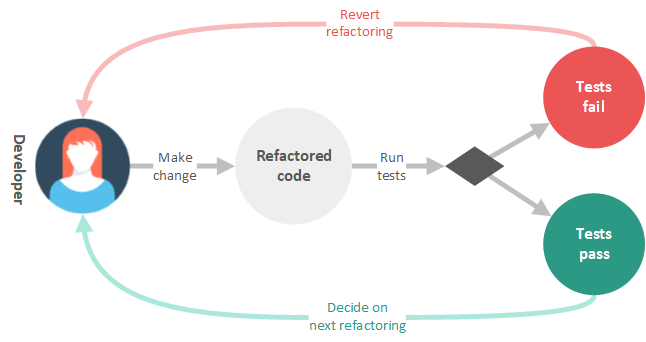
Code Refactoring Best Practices that will Help You in Your Daily Work
When creating an application, we often notice that adding new functionalities starts to cause problems. Under the pressure of time, we start to go around them by applying strange and incomprehensible changes to the code. Doing so may force us to rewrite part of the application and not deliver it on time. This is obviously one of the worst-case scenarios, but it's certainly real. The solution is code refactoring. In this article, we'll show you what it is and why it's so important.
Definition of refactoring
Refactoring is the process of introducing changes to the program, not resulting in new functionalities but in improving the current infrastructure and its quality. The actions we undertake during refactoring concern modifying the code and adjusting it to the standards in force in a given project and searching for new standards created during the development of the project and defining them.
Why is refactoring your code important?
Refactoring makes our code easier to understand. It’s very often the case that the developer reads the code more than writes it. Knowing this, we should make our code easy to understand. This will allow us to work faster and facilitate the onboarding of new team members. Regularly checking and "cleaning" our code is very important.
Refactoring makes our code easier to modify. A well-designed application is much easier to develop. If we take care of the appropriate structure of our software from the very beginning and correct the things that don't match the adopted rules and standards, we'll get rid of the problems that we may stumble upon in the future. Our colleagues from the team will be grateful for this!
Refactoring allows us to understand someone else's code better. When we analyze a piece of code created by someone else, we may acquire knowledge that we may be able to take advantage of in the future. Refactoring is a good way to share knowledge, which is very important when working as part of a team.
Code refactoring best practices
During our professional programing career, we encounter many rules that we should apply during our work. All the more so, we should keep them in mind during code refactoring. Here are some examples of these rules.
Having good knowledge of the application
Before we start to modify the existing code in any way, we should be sure that we have a good understanding of our application in terms of code and – more importantly – in terms of business. Let's keep in mind that refactoring is about improving, not modifying the code. We don't want to change the way our application works.
KISS – Keep It Simple, Stupid
Let's make sure that the functionalities of our application are created in the simplest possible way. It will make them easier to understand and modify by someone else. It will also save us debugging time if something doesn't work in the way we’d like it to.
Creating functions based on the SOLID principles
SOLID is an acronym that represents a set of rules. It was created by Robert C. Martin, better known as Uncle Bob. He is recognized by many developers as an authority.
We should apply these rules in object-oriented programing of applications. Let's analyze what each of these letters stands for.
- S - Single Responsibility Principle. Every class should have one purpose. We should limit what a single class can do and create more as needed. The idea is for every class to do one thing and do it well.
- O - Open/Closed Principle. According to this principle, code should be "easy to extend, closed to modifications". Therefore, we should use inheritance mechanisms and access modifiers appropriately.
- L - Liskov Substitution Principle. This principle means that our code should work properly with all classes and subclasses it inherits.
- I - Interface Segregation Principle. Every interface we create should manage as few things as possible at once, which will make it easier to introduce any possible changes to them.
- D - Dependency Inversion Principle. We should ensure that high-level classes don't depend on low-level ones. If that is the case, we should create classes that function as "bridges" between them.
You might also like: Improving code quality with the PHP_CodeSniffer tool
DRY - Don’t Repeat Yourself
This is a very important rule. Following DRY allows us to solve many problems that we may encounter while expanding the application. We should avoid repetitions in the code like the plague. All the functionalities that we create should be universal enough so that we don't have to create new, very similar functions that we'll use only once. Getting rid of repetitions allows us to limit the mistakes that we might make when modifying functionality in one place and omitting its second version elsewhere.
Choosing the right design pattern
If we encounter a problem that we don't know how to solve, we may find help in design patterns. They are a collection of solutions to the problems frequently encountered in software development. They may be divided into three groups:
- Creational patterns – introduce more flexible mechanisms for creating objects and allow for reusing the created code.
- Structural patterns – explain how to assemble objects and classes into larger structures while maintaining the flexibility and efficiency of these structures.
- Behavioral patterns – deal with effective communication and assignment of responsibilities between objects.
Cooperation with the Project Manager and the Product Owner
It's hard to understand how an application works just by looking at its code. Especially if it's badly written. Active cooperation with the Product Owner and the Project Manager may be of help here. They know the business side of the application, so they may answer all the questions and ambiguities that may arise during code refactoring.
Testing, testing, and some more testing
After the code refactoring is completed, we should obligatorily check whether the application still works in terms of business as it did before our changes. For this purpose, we should run automated tests or pass our changes to a manual tester who knows the project very well and will be able to find all the changes that shouldn't be introduced.

Source: DZone
Code refactoring best practices – summary
Refactoring is a very important process in software development. If there is a need for it, it shouldn't be treated as an undesired cost but rather as a wise investment in our project. A well-conducted refactoring will allow us to save a lot of time, and thus – also money when we'll have to expand our application in the future.
If your software is written in PHP, as PHP development specialists, we can analyze its code and then prepare some tips for its improvement. We may also modernize your web application or website ourselves.










